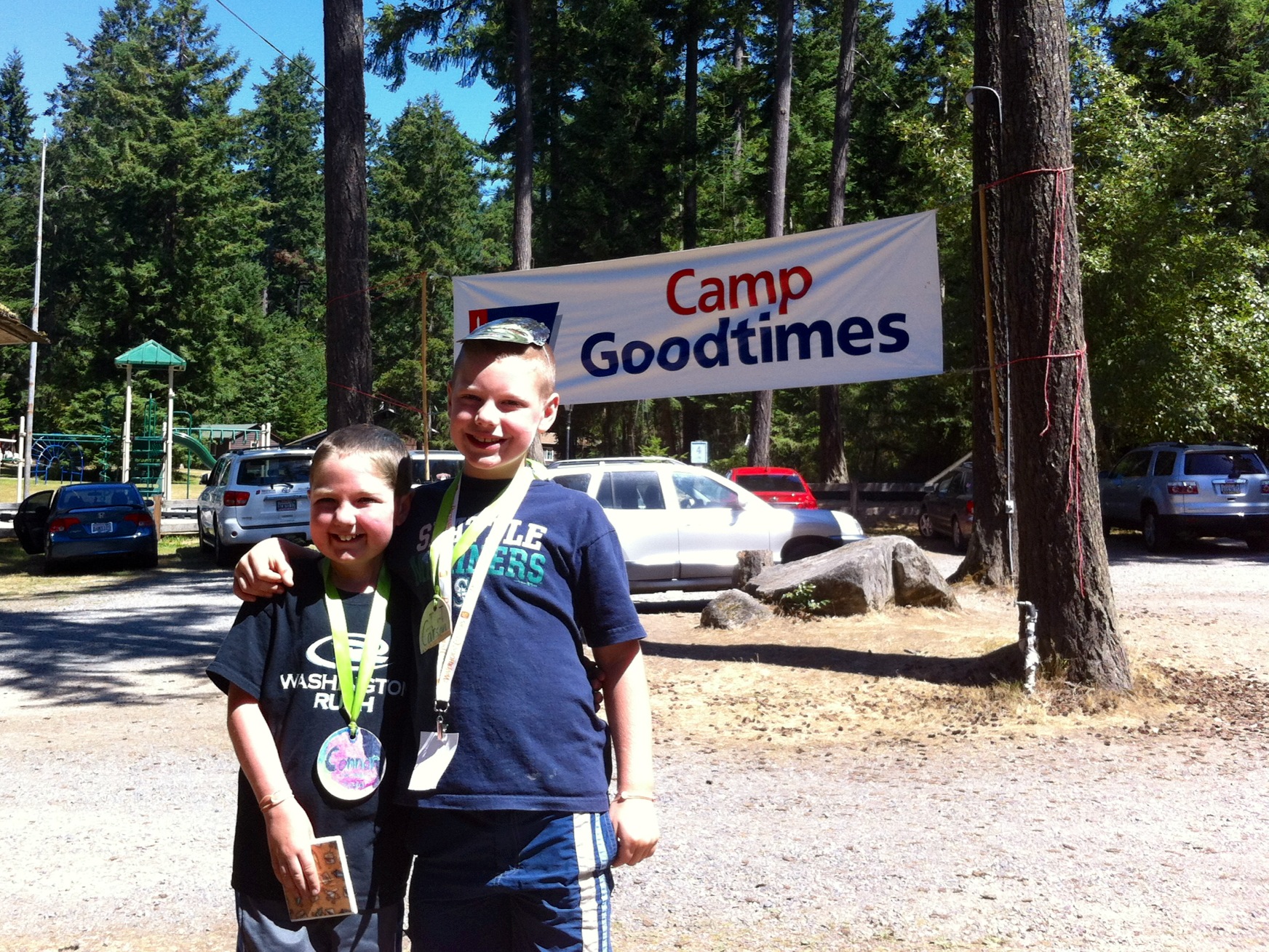
When Connor Dunham attends a session at Camp Goodtimes, he immediately feels right at home.
Connor, 10, was diagnosed with Acute Lymphoblastic Leukemia (ALL) at age 2 and had a bone marrow transplant soon after. At 7, he had the good fortune to become a camper for the first time at Camp Goodtimes, a camp for children and their siblings whose lives have been touched by cancer.
“For one week a year Connor is able to not feel different from his peers. He is able to be around other kids who truly understand how difficult daily life can be when you have had cancer,” says Connor’s mother, Alicia Dunham.
“Connor has struggled with being ‘different’. He is much smaller than his peers and because of losing range of motion in most of his joints as a complication to the transplant, he can't run as fast or move as well as other kids. When he is at camp he comes out of his shell, he is up on stage singing and dancing, he is running around doing a conga line and he is just being a kid ... something he has missed out on.”
I have experienced a similar feeling to Connor’s — the feeling of belonging somewhere with people who understood exactly the highs and lows of what it is like to be deaf.
I grew up without any friends who had profound hearing losses like me (there were only a few fleeting acquaintances). It wasn't until I went to graduate school that I made my first friend who was deaf. It felt like I was looking at a mirror image of myself. There was someone who finally "got" me.
The most surprising thing about our camp isn’t actually about cancer. It’s about rekindling the joys of childhood and community.
Then in 1994, I attended my first Alexander Graham Bell Association for the Deaf convention, and my world changed. The Bell convention is put on every two years and is attended by professionals working in the hearing-loss field, parents of kids with hearing loss, and children and adults with hearing loss. There are myriad sessions, from the latest research in hearing technology to panels on topics like job-seeking tips and social issues. It was as if a wall came crumbling down. I didn’t feel so alone anymore.
And like AGBELL conventions, Camp Goodtimes offers that incredibly important aspect of getting people together: building community.
[It's] "the sense for both siblings and survivors that they’re not alone, that they’re a part of a community that knows what it looks like to have experienced what they did — in very formative years of life," Gus Peterson, the camp's director, says. "I constantly say that the most surprising thing about our camp isn’t actually about cancer. It’s about rekindling the joys of childhood and community ... [this is] possibly life-altering for both the volunteer and camper.”
Pediatric oncology camps are all over the U.S. and offer so many benefits for kids. There are many physical changes and side effects for a child who has cancer and goes through treatment. Many of these are reversible, such as weight gain/loss or loss of hair. Some that are permanent include amputation of limbs or skeletal abnormalities. All these physical changes have an enormous impact on a child’s self-confidence and body image.
I can only imagine how difficult this must be. Hearing loss, for example is one of the most invisible disabilities (unless the person starts signing or speaking with an “accent”— I have been told I sound French), so it is easy to hide behind a façade and pretend you understand something even when you don’t. A physical disability or disfigurement is noticeable and causes attention when you don’t want it.
So for these kids, going to a camp where they are just like everyone else offers a respite from all of that. I asked Peterson what makes this camp unique, and he responded: "The donor and volunteer community ... There is a spirit of well-stewarded joy that lays the foundation for everything we do.”
Over the last few years, the American Cancer Society has stopped funding for several pediatric oncology camps across the U.S. In 2012, funding was withdrawn for Camp Goodtimes. But by that time, supporters had stepped up, forming an executive leadership team to weather the upcoming changes. Members were former campers, survivors and camp staff and hailed from a number of organizations including Microsoft, the Port of Seattle, Seattle Public Schools, Renton Public Schools, Seattle Children’s Hospital and Waggener Edstrom.
Kyle “Wasabi” Krum, one of the people on the team who co-founded the nonprofit foundation, The Goodtimes Project, explained the motivation behind coming together to help keep the camp going.
“Camp was incredibly special to us. It’s one of those places that once you spend time there, it touches your heart and you are always part of the camp family.”
When I asked Krum about his nickname, he explained, “Everyone at camp has to have a nickname. I struggled to find a name, and if you don’t have one by the time camp rolls around, someone will give you one, and you want it to be something good and fun ... I can’t tell you the number of times I have heard “Wasabi!” being yelled from campers, parents or staff in downtown Seattle or in a local super market.”
"Every time I am invited to attend an event or a meeting I feel like I have a backstage pass into a secret club of amazing people," says Alicia Dunham, Connor’s mother. "I am in awe that this group cares so much about my children and the others [who] benefit from camp that they would spend countless hours trying to figure out a way to make it continue."
"My wife Gretchen [a survivor of childhood leukemia] often says, 'doctors and medical science healed my body, but camp saved my life,'" says Gus Peterson.
More about Camp Goodtimes:
- There are three main sessions of camp each summer: Two resident camps with identical programming for children 7–17, and a third camp for young adult cancer survivors ages 17–25. All camps take place in the San Juan Islands in August and are free of charge to the families.
- There are two full-time staff (a Camp Director and Executive Director) and 75-80 full-time volunteers, including medical staff, who support up to 120 campers per resident camp.
- Parents can use this resource to find accredited camps in their area. In addition, there are many pediatric oncology camps in the US, and a few in Washington. Check out the Children’s Oncology Camping Association International.
- Donations are always needed. Check out this extensive list for in-kind items. You can participate in the annual wine auction, which is the main fundraiser for the camp. This year $190,000 was raised!









